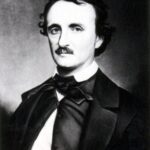Geoffrey of Monmouth
Any history of Merlin must begin with Geoffrey of Monmouth. It is from his work that the character of Merlin first arises, laying the foundation for all that has come since. Although Geoffrey based his own work on earlier sources, he is the true visionary of all that Merlin was and all that he could become.
In the earliest tales of Merlin he is not associated with Arthurian lore at all. In medieval Welsh poems he is Myrddin Wyllt (Myrddin the Wild). After going mad in battle Myrddin runs off to live in the Caledonian forest, a wild man. Even so his madness has also given him the gift of prophecy, and it is as a wild prophet he is known. Myrddin’s character itself was based on earlier Scottish stories of Lailoken, who became Myrddin in the Welsh tales.
Geoffrey of Monmouth became enraptured with the character of Myrddin (although it would seem he did not know all the tales of Myrddin in his early work, nor that Myrddin does not appear until a generation after the time of Arthur). Latinizing his name to Merlin (how he is now universally known), Geoffrey interrupted his work on the Historia Regum Britanniae (History of the Kings of Britain) to publish the Prophetiae Merlini (Prophecies of Merlin).
These apocalyptic prophecies claim to see far into the future and foretell the fate of Britain. The book was widely popular in Geoffrey’s day and he incorporated the work as Book VII his larger Historia. So popular were the Prophecies of Merlin, in fact, that new prophecies attributed to Merlin continued to be written until the 17th century.
Merlin enters the Historia as a boy living at the time of King Vortigern. Vortigern is attempting to build a tower but it will not stand. Summoning his magicians they inform him that in order for the tower to stand he must sacrifice the blood of a boy with no father. That boy, it turns out, is Merlin.
Here we see the first mention of Merlin’s demonic parentage, born of a Welsh princess but sired by a demon, an incubus who visited his mother in the night until finally she was with child. It is to this demonic parentage that Merlin’s powers of prophecy are attributed.
Vortigern informs the boy he is to be sacrificed but he scoffed, informing him the tower would not stand because it was built upon a pond, and below the pond a cave with two dragons. He then goes on to explain how the two dragons symbolize the Britons and the Saxons and foretells the future of the Britain, the fall of Vortigern and the ultimate rise of Arthur. Shortly after Merlin falls into the prophecies which make up the Prophetiae Merlini.
The Historia also tells of Merlin’s construction of Stonehenge (known to Geoffrey as the Giant’s Circle or Giant’s Ring), his association with Uther Pendragon and his role in Uther’s seduction of the lady Igraine through magic and deceit leading to the conception of Arthur. Here, however, Merlin’s role ends in Geoffrey’s telling: Merlin does not take a role in the life or court of Arthur.
Several years after the publication of the Historia Geoffrey returned to the character of Merlin, having found further information on his life. This is the basis of his Vita Merlini, a tale which seems to tell a very different story than that of the Historia and puts Merlin in a later time. Many authors have speculated that Geoffrey was in fact writing about two different Merlins: Myrddin Emrys, the wizard of the time of Vortigern and Uther Pendragon and Merlin Caledonensis, the wild man of the Caledonian Forests.
Robert de Boron
Geoffrey of Monmouth laid the groundwork for Merlin, but it was Robert de Boron who brings in some of the most important elements in the story of Merlin. Boron’s Merlin is also fully immersed into the world of Christianity, elements not existing in Geoffrey’s Merlin tales.
Boron takes the story of Merlin’s demonic origin a step further, claiming him the son of the Devil and a nun (rather than Geoffrey’s Welsh princess) conceived to be the anti-Christ, or at least an anti-Christ. These devilish dreams are quickly squelched with his early baptism. Although the baptism undoes the evil nature of Merlin, it leaves his magical and prophetic powers intact.
It is in Boron’s Merlin that the motif of the sword in the stone first appears (although it was originally an anvil). Here Merlin is the builder of the Round Table, and it is also in Boron’s tale that the idea of the Holy Grail was first introduced into the Arthurian story.
Previous tales related to Perceval had mentioned the Grail, however it was not the Holy Grail as we see it today. It was Boron who linked the Holy Grail to the chalice of Christ, from which he drank at the last supper. Not only did this addition greatly impact Merlin, it began one of the most important aspects of the entire Arthurian legend.
Boron also favors Merlin’s ability to change into different animals, an element that also played a large role in TH White’s The Sword in the Stone. Merlin’s end seduced by Niniane, Lady of the Lake, and entrapped in an oak tree (or in some versions a cave) is also first told in Boron’s Merlin.
Merlin in Later Works
With the foundation laid, later works discussing Merlin continue along the same veins, although as always there are additions and retractions. Although forever tied to the Arthurian legend, he is larger than just these tales. His influence looms over the Arthur stories, and he is backed by a sufficient body of work to make him an independent character all his own.
In the 20th century the most important work of Arthurian literature is most certainly TH White’s tetralogy The Once and Future King. Merlin features prominently early in the series, although his influence peters out as Arthur grows into his own man. White is the first to suggest that Merlin in fact lives backwards through time, a trait that many have followed up on in subsequent versions. In a later novel, The Book of Merlyn, Merlin returns to advise an aged King Arthur in his last years.
Other modern retellings have focused on Merlin, telling the tale of Arthur from Merlin’s point of view (such as in Mary Stewart’s The Crystal Cave or Robert Nye’s Merlin, he also plays an important role in Marion Zimmer Bradley’s The Mists of Avalon).
Merlin is an important figure in fantasy literature, even outside of Arthurian tales. He is a prominent figure in C.S. Lewis’s apocalyptic That Hideous Strength, where Merlin’s magic is ultimately unleashed in all of its power. Other stories of the period had him returning to assist in the efforts of the Allies in World Wars I and II, although others had him playing more mundane roles (such as playing magic tricks at a sporting event in “The Enchanted Week End” by John McCormac.
Summary
The figure of Merlin looms large in the tradition of western fantasy literature. He is the quintessential wizard: prophet and sage, magician and sorcerer, advisor and puppet master, all rolled into one. Outside of his critical role in the Arthurian sagas he is a figure of power in his own right, one who shall always remain prominent in the world of fantasy literature.



